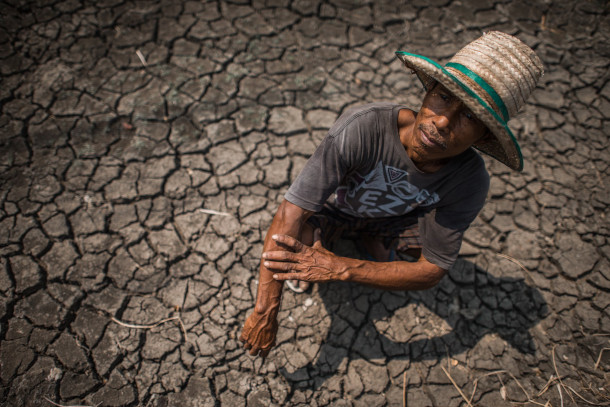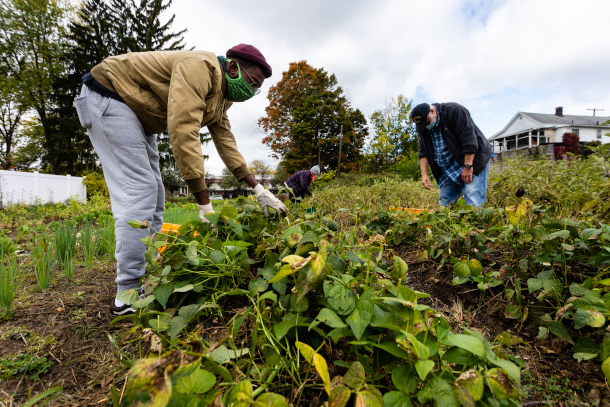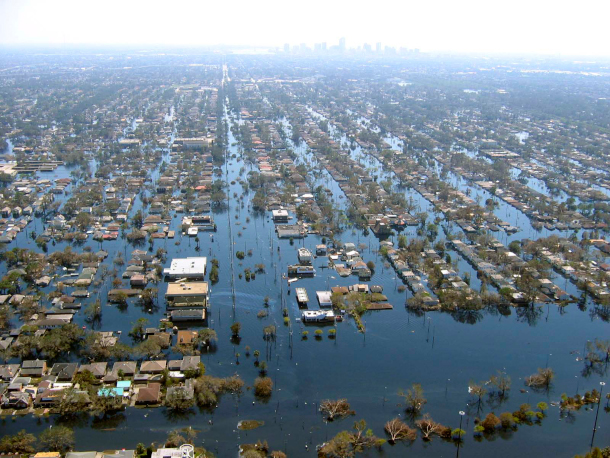IPCC’s “Atlas of Human Suffering”
Air Date: Week of March 4, 2022

The IPCC report warns that across all types of agriculture drought has caused financial and emotional affliction across farm communities. (Photo: UNDP Thailand, Flickr, CC BY-NC-ND 2.0)
The latest report from the United Nations Intergovernmental Panel on Climate Change warns that the climate emergency is at risk of becoming a disaster for human civilization. Professor of Geosciences and International Affairs at Princeton University Michael Oppenheimer was a review editor for the Sixth Assessment by the IPCC and joined Host Jenni Doering to discuss how rising heat and seas pose extreme risks to billions of people.
Transcript
CURWOOD: It’s Living on Earth, I’m Steve Curwood
DOERING: And I’m Jenni Doering.
The climate emergency is at risk of becoming a disaster for human civilization, warns a new report from the United Nations Intergovernmental Panel on Climate Change. We’ve heard these warnings since 1990, but this latest assessment provides even more stark detail of how billions of people are highly vulnerable to the disruptive and dangerous effects of global warming. For more we are joined by Michael Oppenheimer, Professor of Geosciences and International Affairs at Princeton University, who was a review editor for the Sixth Assessment by the IPCC. Michael Oppenheimer, welcome back to Living on Earth!
OPPENHEIMER: Thanks for having me again.
DOERING: This report really spells out the impacts that climate change is causing already and is going to continue to cause to humans to ecosystems. And UN Secretary General Antonio Guterres said in a statement about the report that this is really an atlas of human suffering and a damning indictment of failed Climate Leadership. Can you tell us about some of the findings in this report about that suffering about how, for example, climate change is affecting human health?
OPPENHEIMER: Well, the largest cause of climate related mortality in the United States is heat related death. And what we know about the climate is heat waves are already becoming more intense and occurring more often and when they occur people die. There is actually a limit to the body's ability to dissipate heat, which means that at a certain point, where there's a combination of heat and humidity, which, for instance, keeps people from cooling themselves by perspiration, because the atmosphere is too humid to absorb the perspiration, that it's so hot and humid that you can't carry on normal outdoor activities without risking death. That already occurs in certain parts of the world, say, the Persian Gulf region. But the regions in which it'll be too hot on some days in the hot season and too humid at the same time so that humans can go outside and say, do construction in the construction industry, do farming outdoors, kids playing soccer outdoors, it becomes impossible. And that area of the world is going to grow from relatively small right now to larger and larger. And there are places in the US that are going to suffer that combination of high heat and high humidity so that outdoor activity beyond just kind of lying there is simply not going to be possible without taking your life in your hand. That's the kind of change we're looking at in many areas.

The IPCC report warns that if the world reaches 1.5°C of warming about 8% of the world's farmland would become unsuitable for agriculture. (Photo: Will Parson, Chesapeake Bay Program, Flickr, CC BY-NC 2.0)
DOERING: Speaking of that kind of heat and its impacts on humans. You know, according to this latest report by 2050, urban areas could be home to two thirds of the world's population. And we know that many of these urban areas, they have a lot of concrete, they have this urban heat island effect, you know, they don't have necessarily enough greenery. What solutions does this report point to in terms of dealing with this problem?
OPPENHEIMER: Cities actually, because they know about the risk are ahead of national governments in worrying about the future. So in many ways are going to guide the way but they're also hotspots for climate change. And one of the reasons there are hot spots is this urban heat island point that you just made. In areas that are very built up heat tends to not only be generated at higher rates, for instance, that air conditioning for all those buildings spills heat out into the sidewalks. But the concrete itself is a bad surface, both for buildings and for pavement, in that it absorbs a lot of heat during the day and it traps that heat as the normal surrounding area starts to cool off at night. So cities rob us of nature's natural response to too much heat. As a result, they tend to be several degrees hotter particularly at night than the surrounding areas. And so if you think about a hot urban area in the tropics, the tropics are already hot, you lay more heating on top of that from climate change and then you add some more due to the urban heat island effect in the urban areas and you get a really nasty combination. You get possibly much higher temperatures than anybody is used to. And we know what happens when temperatures get too high, as we mentioned before people die. The best example, the most recent example for Americans is the extreme heatwave we had in the Pacific Northwest this past summer. About 200 people died in Washington, Oregon, and Southwestern Canada, an area which is not used to hot weather where there isn't much air conditioning, and where temperatures were much higher than any thing that had occurred in recent history. And scientists were able to look at that event and say, there's no question about it, that would not have happened without the buildup of the greenhouse gases and the climate change. So now, the question for those people is, it's going to happen again, it's probably going to happen a lot more frequently than it ever happened before if it ever happened before. And how are we going to protect people? How are we going to keep hundreds of people from dying? Because next time it might be thousands of people.
DOERING: Well so, what are some of those steps that cities in particular could take to protect people? Because this is a reality it's already here.
I'm an author on the new #ipcc report and I study climate change impacts and adaptation options in #Africa. ????: How bad could it get? Who is most vulnerable? How can we adapt? Here's a report summary for Africa.
— Christopher Trisos (@christrisos) March 1, 2022
full report https://t.co/dqudeKpzbF
tldr https://t.co/BCSOHRQ4rW pic.twitter.com/pGpqH2R18E
OPPENHEIMER: So in a lot of urban areas now in some countries, at least certainly in the United States, roofs on buildings are painted an aluminum type color because it reflects sunlight and it makes the buildings a lot cooler. Building codes now require many cases insulating roofs to keep heat inn in the winter, and keep it out in the summer. There are things that people know how to do, but one thing I'm really worried about are that these are all sort of decisions that have to be made cooperatively, they're collective decisions or governmental decisions. For some parts of the climate problem like extreme heat, we've privatized it, we go around assuming everybody can get air conditioning but a lot of people are poor, they can't afford air conditioning. Or if there's a blackout because of a heatwave because of too much draw, then everybody stuck with that air conditioning. And we've made almost no preparation for those kinds of people or that kind of eventuality.
DOERING: You know, one of the most concerning points in the report is that if we keep emissions at the current rate, at least 1 billion people are at risk of losing their homes as a result of climate change by 2050. So we're talking about an eighth of today's population, you know, an eighth of the people on earth now becoming homeless. What do we know so far about what people living in vulnerable areas can do to protect themselves?
OPPENHEIMER: Well, there are, generically two ways that people become homeless, one is temporary, and the other is permanent. In catastrophic events, like a hurricane, people can be driven from their homes because there's an evacuation. Usually what happens is they go someplace else temporarily and they try to come back. The other kind of migration that occurs isn't really displacement, which refers to the short term phenomena. It's a longer term phenomenon, say, a farmer in a developing country that has a subsistence level of existence and is very dependent on every season being good for production of whatever crop they grow. As the climate changes and as there's less precipitation in some areas, you get to the situation where crop yields decline. And at a certain point the farmer starts to envision that there isn't going to be a livelihood for his family there. And they may decide to move the whole household. And then that's leads essentially to a long distance and in many cases permanent migration. And this is not some arcane phenomena that’s just in a few areas of the developing world. We have it happening here in the United States, where we have coastal regions that are sinking, and where the government offers buyouts of homes. They’re voluntary but what's left behind is a community which is no longer functional in some cases. And somebody has to make a decision essentially, to turn off the lights at a certain point. So that whole process of easing transitions for people, for households and for communities is something our government has only partially grappled with in the United States. That has to be thought about more carefully.

View of flooded New Orleans, Louisiana in the aftermath of Hurricane Katrina. According the IPCC every year half a million people are at risk of flooding and about a billion people living along coasts will be exposed by 2050. (Photo: Commander Mark Moran, NOAA Aviation Weather Center, Wikimedia Commons, Public Domain)
DOERING: The report points to sea level rise, you know, and how it's connected to the level of warming that happens. You know, there's different levels of sea level rise, we could see over the coming decades and hundreds of years, depending on how much the climate warms in the next several decades. And I'm wondering how much of the impact of sea level rise will be something that people can adapt to where they are versus being entirely displaced?
OPPENHEIMER: Depends very much where you live, and how close to the coast you live. So there are some places around the world and in the US, where is the coast of being abandoned already. And that's because you can't build a whole seawall around most coastal countries, you can't build a seawall around the United States. In fact, even in Miami, a big megalopolis, rich place, we want to protect that but because it sits on calcium deposits that are very porous, limestone essentially, if you built a seawall to protect Miami, the water just goes under the seawall through the porous limestone and comes up in the city anyway. Now, certain areas that are geologically possible to protect, like cities that are somewhat further up the coast, like Savannah, New York, Boston. It will be possible to spend a lot of money and I mean, a lot of money building infrastructure like sea walls and surge barriers that will protect those places. And for places that have a high value financially, that'll probably be done. But for places that have neither a lot of money, nor the political cloud to get the money to be spent on them they're going to have to move away from the coast. There is no other option. So what percentage of the population that is? We can't really say at this point, the estimate of a billion people being displaced overall. I think that's a very soft estimate, we really don't know. But the point is if we sit here and do nothing we'll make it a reality. What we have to do is start thinking ahead, do that planning on you know, 30, 40, 50 years ahead. That can work and keep displacement to a minimum.
DOERING: Michael Oppenheimer is professor of Geosciences and International Affairs at Princeton University. Thank you so much, Michael.
OPPENHEIMER: It's been a pleasure.
Links
Read the 2022 IPCC Report: Impacts Adaptation and Vulnerability
Learn more about Professor Michael Oppenheimer
Reuters | “UN Climate Report Urges World to Adapt Now, Or Suffer Later”
The Guardian | “What Is the IPCC Climate Change Report – And What Does It Say?”
Watch the IPCC Press Conference - Climate Change 2022: Impacts, Adaptation & Vulnerability
Living on Earth wants to hear from you!
Living on Earth
62 Calef Highway, Suite 212
Lee, NH 03861
Telephone: 617-287-4121
E-mail: comments@loe.org
Newsletter [Click here]
Donate to Living on Earth!
Living on Earth is an independent media program and relies entirely on contributions from listeners and institutions supporting public service. Please donate now to preserve an independent environmental voice.
NewsletterLiving on Earth offers a weekly delivery of the show's rundown to your mailbox. Sign up for our newsletter today!
 Sailors For The Sea: Be the change you want to sea.
Sailors For The Sea: Be the change you want to sea.
 The Grantham Foundation for the Protection of the Environment: Committed to protecting and improving the health of the global environment.
The Grantham Foundation for the Protection of the Environment: Committed to protecting and improving the health of the global environment.
 Contribute to Living on Earth and receive, as our gift to you, an archival print of one of Mark Seth Lender's extraordinary wildlife photographs. Follow the link to see Mark's current collection of photographs.
Contribute to Living on Earth and receive, as our gift to you, an archival print of one of Mark Seth Lender's extraordinary wildlife photographs. Follow the link to see Mark's current collection of photographs.
 Buy a signed copy of Mark Seth Lender's book Smeagull the Seagull & support Living on Earth
Buy a signed copy of Mark Seth Lender's book Smeagull the Seagull & support Living on Earth

